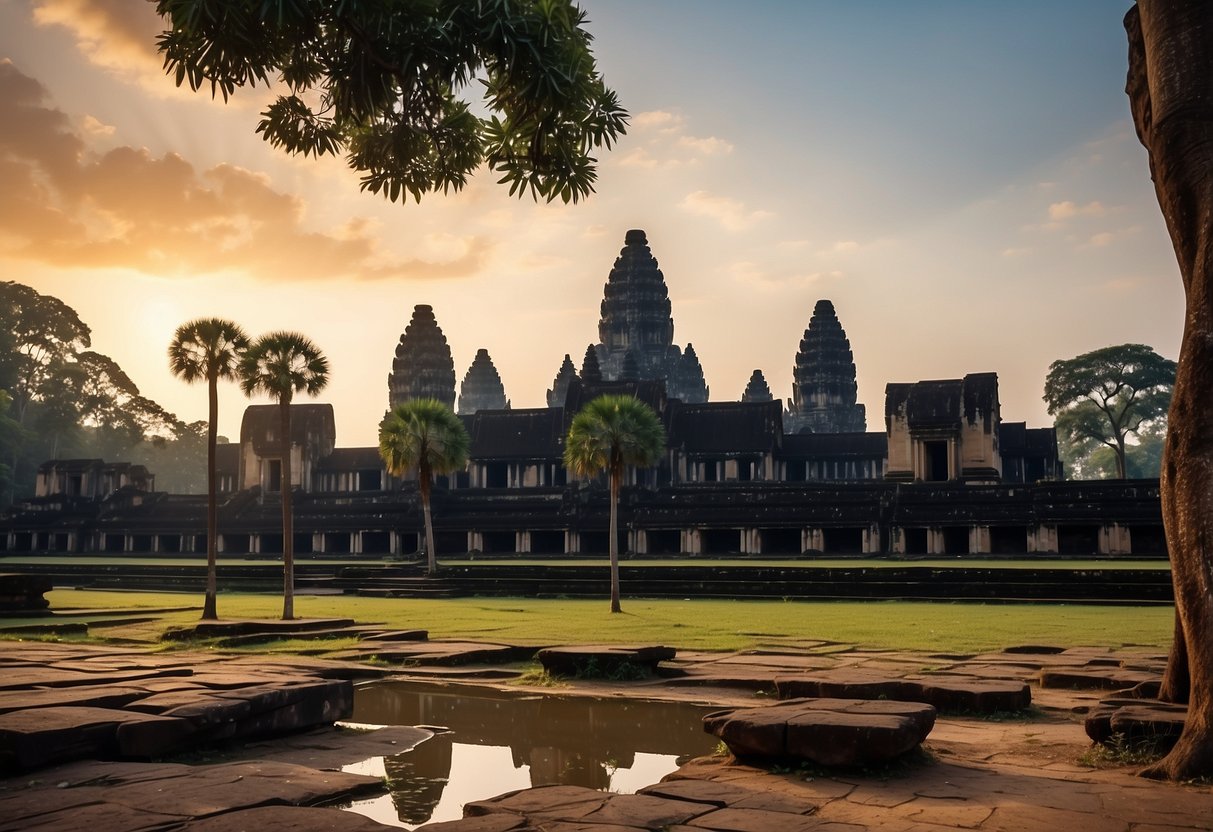
Planning Your Visit to Angkor
When visiting Angkor, timing your trip and understanding the logistics can make a significant difference. Key factors include the best times to visit, transportation options, and the necessary Angkor Pass.
Best Times to Explore
The ideal time to visit Angkor Wat largely depends on the weather. The dry season, from November to April, offers cooler temperatures and fewer rain showers, making it an excellent choice for exploring the temples. January is particularly popular due to its pleasant climate.
The rainy season, from May to October, sees fewer tourists and lush, green landscapes. Mornings after a night of rain can be especially beautiful. Sunrise at Angkor Wat is a must-see, with the best months being February and March for clear skies and vibrant colors. Regardless of the season, early morning and late afternoon visits help avoid the midday heat.
Transportation Tips and Tricks
Siem Reap is the gateway to Angkor, and various transportation options are available from this charming town. Tuk-tuks are a popular and cost-effective choice, providing an open-air experience and easy maneuverability through the temple complex. For larger groups, hiring a private car or minivan can be more convenient.
Bicycle rentals are an eco-friendly option, allowing for a leisurely exploration of the nearby temples. Guided tours, which often include transportation, offer in-depth historical insights and ensure nothing significant is missed. Public bus services from Siem Reap are limited but can be an affordable option for budget travelers. Regardless of your choice, starting early can help in witnessing the iconic sunrise at Angkor Wat.
Understanding the Angkor Pass
The Angkor Pass is required for entry to the temple complex and can be purchased at the official ticket office in Siem Reap. Pass options include a 1-day pass, a 3-day pass, and a 7-day pass, with prices varying accordingly. The 7-day pass is ideal for those wanting a thorough exploration without rushing.
Passholders need to carry their passes at all times within the complex. Personal identification is required when purchasing the pass. With more than a thousand temples, the Grand Circuit encompasses major sites that can be explored over multiple days. This pass system helps spread visits over time, providing a more relaxed and in-depth experience.
The Living Legacy and Culture of Siem Reap
Siem Reap offers a tapestry of living history and rich cultural experiences, bridging the grandeur of ancient traditions with vibrant modern-day celebrations. It is a place where the past and present merge, offering visitors a profound insight into Khmer civilization.
Modern Commemoration of Ancient Traditions
In Siem Reap, many aspects of Khmer culture are still actively celebrated. Ceremonies and rituals, perpetuated by the locals, pay homage to their ancestors and ancient deities. One of the most vivid celebrations is the performance of classical Apsara dance. Rooted in ancient mythology and depicted in Angkor Wat carvings, these dances are a significant cultural expression.
Apsara dancers, clad in ornate costumes, recreate scenes of Khmer epics, ensuring these stories remain alive. Temples become living museums, where both Khmer people and visitors can engage with the past. This commemoration also extends to numerous festivals, such as Pchum Ben, which involves offerings to ancestors. These traditions showcase the strong connection the Khmer civilization maintains with its history.
Cultural Experiences Beyond the Temples
While the temples are a major draw, Siem Reap offers a plethora of cultural experiences that provide deeper insight into the local way of life. Visitors can explore vibrant markets bustling with activity where traditional Khmer handicrafts like silk weaving and stone carving are sold. These markets are a great way to observe the skilled artisans at work.
Further, local workshops offer tourists the opportunity to try their hand at craft-making, from pottery to painting. This hands-on experience is invaluable in appreciating the intricacies of Khmer artistry. Additionally, traditional Khmer cooking classes provide an immersive experience into the regional culinary heritage, highlighting the flavors and techniques that have been passed down through generations.
Siem Reap thus serves not just as a gateway to ancient ruins, but also as a living museum of Khmer culture and traditions.